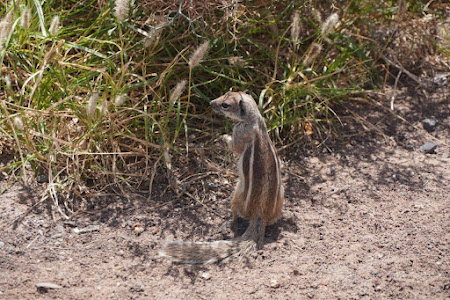The salt marshes in the tourist resort of Jandia in the south of the island of Fuerteventura are the only wetland of international importance on the Canary Islands. Strictly protected from human use, they are nevertheless in danger - but from invasive species. Such species originate from other parts of the world and are called neophytes (in the case of plants) or neozoa (in the case of animals). Since they can spread in the new habitat without their traditional enemies and competitors, they sometimes have a considerable impact on local ecosystems.
For Playa de Matorral, two species will be presented in more detail below.
A North American plant (of the plant family Faboideae) was probably introduced from Mexico for horticultural purposes on Gran Canaria and Fuerteventura. The species Desmanthus permanbucanus (Pigeon bundleflower) is considered to be a proliferating weed. The Faboideae plants are able to accumulate nitrogen as nitrate in the soil through nodule bacteria in the roots. In agriculture, they are therefore planted as a green fertiliser. In natural habitats, however, this causes a strong change in soil chemistry and is a threat to plants adapted to nutrient-poor soils. This has an effect, for example, in the barrancos, the erosion gullies in volcanic deposits on the island. For more information, see Verloove, F. & Borges, L. M., 2018: On the identity and status of Desmanthus (Leguminosae, Mimosoid clade) in Macaronesia, Collectanea Botanica 37 (https/doi.org/10.3989/collectbot2018.v37.007).
Desmanthus permanbucanus produces a large quantity of small seeds that accumulate in the soil as a seed reservoir and germinate when conditions are favourable. With this dispersal strategy it is difficult to control, as seeds are always left behind that can germinate later. The plant is controlled by pulling out seedlings before they can form seeds themselves or by using plastic sheeting in areas containing seeds.
Either opaque plastic is used to keep the moisture in the soil under the sheeting. The plants that germinate then perish due to the lack of light. With transparent plastic film, germination is accelerated. This makes it easy to observe the growth and the seedlings are then removed.
The ubiquitous North African bristled squirrels (Atlantoxerus getulus) are very popular among tourists. Although there are signs in many places urging people not to feed the animals, many people do not comply. Sometimes they even feed right next to prohibition signs. The Atlas squirrels were brought to the island of Fuerteventura as pets in 1965 and were able to spread almost everywhere due to the lack of natural enemies. Only in hotel complexes with cats no squirrels are found.
They are considered pests for the island's agriculture and a threat to native plants and animals. They compete for food with the native Eastern Canary Island lizard (Gallotia atlantica) or cause changes in the composition of plant communities. For example, they support the spread of prickly pears, which are also not native to the Canary Islands. Their juicy fruits are readily eaten by the squirrels on the very dry island. The aim is to prevent the squirrels from spreading to other islands (e.g. through ferry traffic). First settlement attempts on Gran Canaria or Lanzarote were probably successfully stopped.

No comments:
Post a Comment